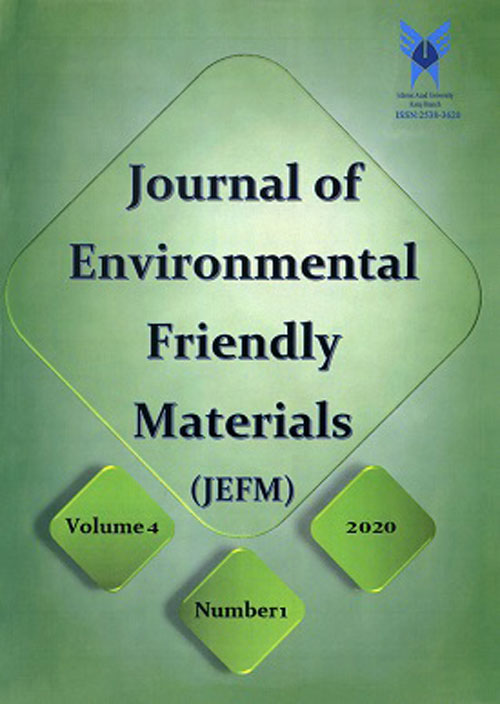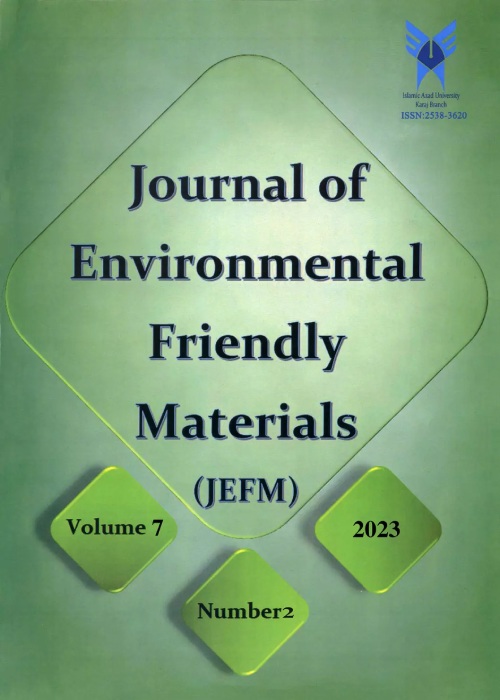فهرست مطالب

Journal of Environmental Friendly Materials
Volume:4 Issue: 1, winter-spring 2020
- تاریخ انتشار: 1399/03/31
- تعداد عناوین: 8
-
Pages 1-5
In order to increase the corrosion resistance and improve the biocompatibility of Ti-6Al-4V alloy used in medical applications such as implants, it has been modified with various methods including PEO. On the other hand, this alloy is also capable of heat treatment. In this study, firstly different structures were obtained by heat treatment of Ti-6Al-4V substrate and then different structures were coated with the same parameters, by PEO method. The scanning electron microscope equipped with EDS was used to investigate the morphology and cross-sectional of the coatings. X-ray diffraction was also applied to analyze the phases created in the coating. Additionally, investigation of surface topography was performed by atomic force microscopy. Results have represented that the martensitic structure has a lower porosity with more regular dispersion. The creation of coating with martensitic structure also shows good thickness with high quality smoothness. On the other hand, the coating of the α-plate and inter-grain β structure were included large and irregular porosities.
Keywords: Ti-6Al-4V, Heat treatment, PEO, Porosity -
Pages 7-13
Heat recovery steam generator (HRSG) is obviously a very desirable and environmental friendly energy source, increasing thermal efficiency while reducing energy costs is possible through the use of industrial boilers. In this study, the effect of high frequency resistance welding (HFRW) variable factors on joints between AISI 409 stainless steel finned to 2 ¼ Cr-1Mo alloy steel tube as helical finned tube was investigated. So HFRW was implemented on actual samples by changing multiple factors including travel speed, electric potential, current of welding and fin pitch. Meanwhile metallography of weld joint, tensile strength and hardness tests were carried out several sections of the samples according to international standard fin tube. The diffusion zone indicating metallurgical joining more than 90% was measured at the weld interface, with applying optimum welding parameters, fin-tipand tube-tipposition and hydraulic pressure jack setting on squeeze rollers. Furthermore as the lower pitch and fin thickness are selected, the higher quality of fin tube welding joint is achieved. On the other hand as the pitch and fin thickness are reduced, the output transfer surface treatment in final process diminished. However, this paper presents emphasis on finned tube manufacturing processes and the best weld parameters conditions have been reached a sound joint.
Keywords: Heat recovery steam generator_Resistance Welding_AISI 409_Finned tube_2 ¼ Cr-1Mo -
Pages 15-23
In this study, lead titanate nanopowder was synthesized using mechanical activation. Raw materials including titanium oxide powder (anatase) and Lead oxide (ІІ) with a ball to powder weight ratio of 1: 10 and the powder ratio of 1:1 were milled in a planetary ball mill for 30 hours. Then, they were heated at 800, 900 and 1000 °C. The volatility of lead and the formation of secondary phases were prevented using this method. The obtained nanopowder was investigated by field emission scanning electron microscope (FESEM), X-ray diffraction (XRD), and Fourier transform infrared spectroscopy (FTIR). The UV absorption spectroscopy was used to calculate the energy gap. Photocatalytic activity of nanopowder by dye degradation of methyl orange under UV light was evaluated. The effects of various influential parameters including initial dye concentration, photocatalyst dose and pH on the dye decolorization were also investigated. The optimum value for initial dye concentration and photocatalyst dose, obtained 10 ppm and 0.042 g, respectively. Also, the best rate of decolorization observed at pH=4. The results suggested that photocatalytic process is a beneficial method for decolorizing methyl orange dye.
Keywords: Lead Titanate Nanopowder, Mechanical activation, Photocatalyst, Methyl Orange -
Pages 25-29
The present study investigates the effects of type of shielding gas on the depth, width and hardness of 17-4PH stainless steel. For this purpose, pure He, pure Ar and 80%Ar + 20% He were used as shielding gases in TIG welding of 17-4PH SS. Weld depth and width of specimens were measured by macro etching. Microstructure of welds was studied by using SEM technique. Moreover, micro Vickers hardness test was accomplished to gauge the hardness of welds. Results showed that specimen welded with pure He has the highest hardness values in the weld zone due to the reduction of δ-ferrite formation in the martensitic matrix. Furthermore, owing to the lower thermal conductivity and heat input of Ar gas, specimen welded by pure Ar has the shallowest and narrowest weld bead. However, due to produce hotter arc by addition of He in shielding gas, enhancements observed in the weld depth and width of specimens welded with pure He and 80%Ar + 20% He.
Keywords: 17-4PH stainless steel, TIG Welding, Hardness, Microstructure, penetration -
Pages 31-35
Aluminum composites are one of the most important alloys with a wide range of properties and applications. In this paper, we predict the micro-hardness of aluminum-based alloys by artificial neural method (ANN). First, the effective parameters in mechanical alloying include weight percentage and micro hardness of reinforcement materials, milling time, the ball to powder weight ratio, vial speed, the pressure of presses, sintering time and temperature, selected for inputs and micro-hardness of Al composite considered as the output. A feed-forward back propagation artificial neural network designed with 16 and 10 neurons in the first and second hidden layers, respectively. The created network with the mean percentage error of 5.6% was able to predict micro hardness of the Al composites. Finally, the effect of each parameter was determined by sensitivity analysis which volume fraction of alloying elements, milling speed and sintering time had the highest impact on the micro hardness of Al-based composites.
Keywords: Aluminum Alloys, Prediction Micro Hardness, Artificial Neural Network, mechanical alloying -
Pages 37-42
In this research the environmental effects (CO2) of rock wool as a mineral insulation and expanded polystyrene as a polymeric insulation for building insulation is studied. First the intended building is simulated by Design Builder software for cold climates like Tabriz city in Iran, and then the thickness effect of these two insulations is studied at the building’s exterior wall by using Energy Plus simulation engine in Design Builder software in order to find the optimized thickness in terms of environmental effect (CO2). Except considering the gas emission amount of building’s heating and cooling systems in a year, the amount of CO2 gas consumption in production process to installation of various thicknesses has been also taken into account. Finally by using Single Layer Perceptron Artificial Neural Network method, the environmental optimized thickness of insulation in terms of gas emission while consuming energy in building and its production during the manufacturing of insulation over ten years span in cold areas of Iran like Tabriz, is 12.5 centimeters for expanded polystyrene and 8.8 centimeters for rock wool. It is concluded that from gas emission perspective in cold climates, the mineral insulation such as rock wool is has lower optimized thickness comparing to polymeric insulation like expanded polystyrene.
Keywords: Thermal Insulation, Optimum Insulation Thickness, Environmental Analysis -
Pages 43-46
Data-driven studies extensively depend on the quality of measurement data. The quality of the measurement data depends on the statistical characteristics, which is obtained from a number of measurements under stable conditions, from a measurement system. Ensuring accurate measurement data and continuous and timely control of equipment is a great step in improving the quality of components and structures in the welding and inspection industry. During the construction and servicing of parts, it is possible to have a variety of discontinuities with different sizes, that the future function of the piece influences their exact nature and size. Economic and environmental damage caused by the incorrect size of the welding connection will have adverse consequences. Welding industry expansion has made the protection of this industry essential. The purpose of this study is to measure the error rate in the measurement system and to analyze the factors affecting the error in welding inspection. This descriptive and cross-sectional study was carried out on the quantitative inspection results of a refinery distillation tower sample with quantitative MSA and the results of the radiographic examination of the perimeter weld line used in the pipelines by qualitative MSA. Based on the findings, analysis of the quantitative measurement system was approved within the acceptable limits. Qualitative Measurement System Analysis was indicative of noncompliance, as well as re-decision on indicators such as inspection sensitivity, replacement or repair costs, acceptance or non-acceptance of the tool. The measurement system analysis assures customers that the results of the measurement data are in accordance with customer specific requirements and legal requirements.
Keywords: analysis, Measurement system, Welding Industry, Inspection -
Pages 47-54
Today, with regard to population growth, there is a need for more renewable energy sources that can easily serve different human needs without harming the environment; therefore, designing energy saving buildings as well as protecting natural resources is one of the main responsibilities of the experts. One of the types of renewable energies is geothermal energy, which is one of the least costly, most beneficial of these energies and a good alternative to fossil fuels, and the generation of electricity and the heating and cooling of buildings by the heat pump are a number of its applications. This article attempts to explain the use of this energy in heating and cooling buildings and the need to use this cheap and clean energy instead of using fossil fuels.Increasing population and increasing economic prosperity on the other requires energy. The increasing need for energy has led people to increasingly use fossil fuels (coal, oil, gas) but the nonrenewable and contaminations that have emerged, such as global warming, ice melting, and the collapse of the natural ecosystem of the planet, have reduced the use of these energy sources. Therefore, the use of energy sources that are unlimited and cause the least pollution has attracted the attention of researchers in recent decades, which they call the sources of new and renewable energy. One of these sources is geothermal energy, which we will continue to explain.
Keywords: Geothermal Energy, Renewable Energy, Energy Applications, environment


